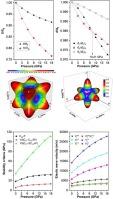具有七膦三环构型的 Sr2P7Br 双锌盐的结构、弹性和热力学性质
IF 3
3区 化学
Q3 CHEMISTRY, PHYSICAL
引用次数: 0
摘要
我们研究了外加压力对 Sr2P7Br 化合物特性的影响,特别是其晶体结构、弹性和热力学。这项研究是在密度泛函理论框架内使用伪势平面波方法进行的。我们使用了专门为固态分析设计的交换相关一般梯度近似的著名 PBEsol 变体。这是首次使用理论方法研究压力对 Sr2P7Br 材料的影响。计算得出的平衡结构参数与相关的实验对应值非常吻合。在环境压力和高达 18 GPa 的静水压力下获得的弹性常数满足机械稳定性要求。根据计算得出的普氏比、考希压力和泊松比,可以得出结论:Sr2P7Br 化合物具有韧性行为。根据单晶弹性常数推导出了多晶弹性模量,包括各向同性体积模量、剪切模量、杨氏模量和泊松比,以及在环境压力和压力效应下的弹性模量。此外,还研究了压力影响下的相关参数,如平均声速、德拜温度、最小热导率和维氏硬度。在 0、4、8、12 和 16 GPa 的固定压力下,使用准谐波德拜近似来研究温度与一些宏观物理参数(如晶格参数、体模量、德拜温度、体积热膨胀系数以及等压和等热容)之间的关系。根据弹性常数得出的结果与使用德拜准谐波模型计算得出的结果非常一致,从而验证了我们研究结果的可靠性。本文章由计算机程序翻译,如有差异,请以英文原文为准。

The Structural, Elastic, and thermodynamic properties of Sr2P7Br Double Zintl salt with heptaphosphanortricyclane configuration
We investigated the effects of externally applied pressure on the Sr2P7Br compound’s properties, specifically its crystalline structure, elasticity, and thermodynamics. This investigation was carried out using the pseudopotential plane wave method within the framework of density functional theory. We used the well-known PBEsol variant of the exchange–correlation general gradient approximation specifically designed for solid-state analysis. This is the first endeavor to investigate the effects of pressure on the Sr2P7Br material using a theoretical approach. The computed equilibrium structural parameters closely match the relevant experimental counterpart values. The determined elastic constants, obtained under both ambient pressure and hydrostatic pressures up to 18 GPa, satisfy the mechanical stability requirements. Based on the computed Pugh’s ratio, Cauchy pressure, and Poisson’s ratio, it can be concluded that the Sr2P7Br compound exhibits ductile behavior. The polycrystalline elastic moduli, including the isotropic bulk modulus, shear modulus, Young’s modulus, and Poisson’s ratio, at ambient pressure and under pressure effects, were derived from the single-crystal elastic constants. Additionally, associated parameters, such as average sound velocity, Debye temperature, minimum thermal conductivity, and Vickers hardness, were examined under pressure influences. The quasi-harmonic Debye approximation was used to investigate the relationship between temperature and some macroscopic physical parameters, such as lattice parameter, bulk modulus, Debye temperature, volume thermal expansion coefficient, and isobaric and isochoric heat capacities, at fixed pressures of 0, 4, 8, 12, and 16 GPa. The results derived from the elastic constants exhibit substantial concordance with those computed using the Debye quasi-harmonic model, thereby validating the reliability of our findings.
求助全文
通过发布文献求助,成功后即可免费获取论文全文。
去求助
来源期刊

Computational and Theoretical Chemistry
CHEMISTRY, PHYSICAL-
CiteScore
4.20
自引率
10.70%
发文量
331
审稿时长
31 days
期刊介绍:
Computational and Theoretical Chemistry publishes high quality, original reports of significance in computational and theoretical chemistry including those that deal with problems of structure, properties, energetics, weak interactions, reaction mechanisms, catalysis, and reaction rates involving atoms, molecules, clusters, surfaces, and bulk matter.
 求助内容:
求助内容: 应助结果提醒方式:
应助结果提醒方式:


